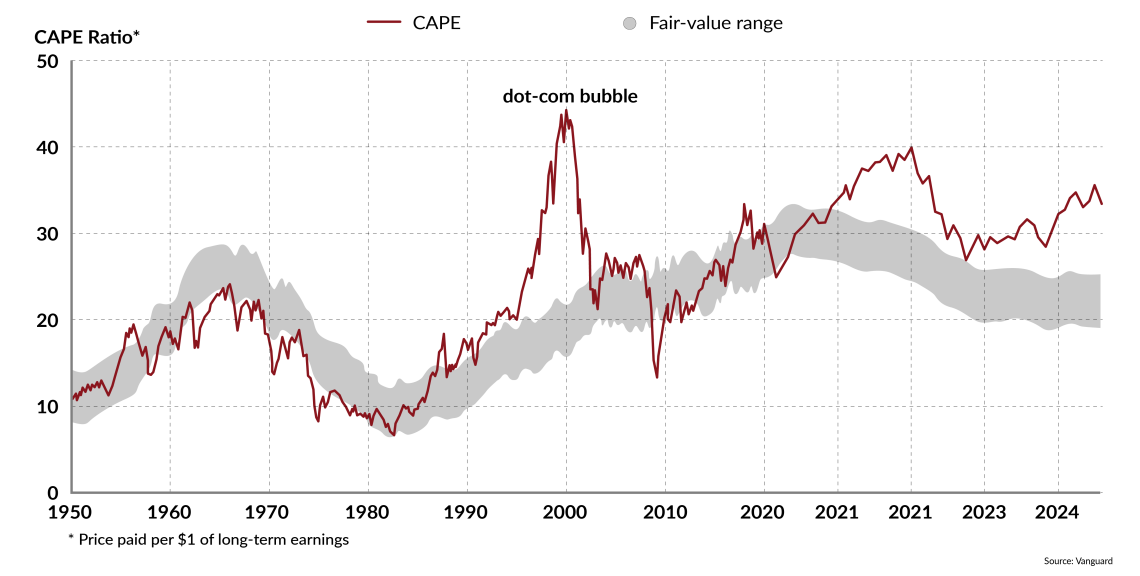Is AI the new dot-com bubble?
The AI boom of today contains echoes of the dot-com bubble of the late 1990s – but does the tech match the hype?

In a nutshell
- Investors are jumping on AI, often with little grasp of the technology
- Soaring stock prices raise concerns of a new tech bubble
- AI start-ups, while more powerful than dot-com firms, must adapt to survive
- For comprehensive insights, tune into our AI-powered podcast here
The rapid growth of the artificial intelligence sector has stirred widespread excitement and optimism among investors. Entrepreneurs, the public, governments and regulators are all still scrambling to understand and anticipate the big-picture shifts that the new technology will bring to our economies and societies. The financial markets, however, seem to have come to a unanimous verdict: Regardless of the broader implications, investing in AI is a bet one cannot afford not to place. As a result, the sector is seeing extraordinary capital inflows, to the extent that many analysts and market observers have already raised concerns over a possible bubble forming – one that is reminiscent of the dot-com crisis of the late 1990s and early 2000s.
Bubble territory
The astounding amounts raised by leading AI and AI-related companies have been making headlines for some time. OpenAI alone has raised nearly $63 billion since its founding in 2015, while Anthropic has secured around $27 billion in the four short years since its launch in 2021. To put this into perspective, it took SpaceX, arguably one of the most ambitious and capital-intensive ventures in modern memory, over two decades to raise around $12 billion, and its total valuation of $400 billion has now been surpassed by OpenAI’s $500 billion.
In early September, Oracle’s stock price, despite reporting earnings that fell below expectations, surged 36 percent after the software giant announced that it expected its AI-fueled cloud revenue to reach $144 billion by 2030. The company’s stock price increase was the biggest single-day gain since 1992 and added roughly $250 billion to its market capitalization overnight – all due to the mere mention of AI.
Facts & figures
AI hype spurs stock overvaluation

Even OpenAI’s Sam Altman himself sounded the alarm: “Are we in a phase where investors as a whole are overexcited about AI? My opinion is yes.” It is therefore no surprise that concerns over entering bubble territory are on the rise, as are attempts to draw parallels with the dot-com crisis.
Common denominators
Clearly, there are a few striking similarities between the AI market today and the dot-com bubble of the late 1990s that cannot be overlooked. The rise in valuations, the rush to invest in anything even remotely AI-related and the explosive proliferation of all kinds of AI-themed products and services are chief among them. The dot-com bubble was born of comparable trends: Companies with little more than a business plan (even a very poor one in some cases) and a catchy name quickly achieved extraordinary valuations, simply because they attached themselves to the most exciting new technology of their time.
We saw this again in 2017 during the mania for crypto, when companies simply added the word “blockchain” to their name (sometimes without even implementing any blockchain-related technologies) and were rewarded with investors flocking to buy their stock. Much like how “.com” and “blockchain” were used to rally investors in the past, adopting the “AI” label serves a similar purpose now – even if it is just a marketing ploy.
The idea that a company is harnessing AI in some way instantly makes it more attractive, regardless of whether the technology is meaningfully integrated into its product or, for that matter, whether the product is even viable. This is largely because now, like before, most investors, as well as the broader public and the media that hype these companies, lack a deep or even basic grasp of the underlying technology.
This knowledge gap made it much easier in the 1990s to market unrealistic or simply poorly thought-out and unworkable concepts that stood no chance of succeeding in the real world. The same dynamic exists today: Flashy demonstrations of AI capabilities dazzle investors who are not properly qualified to judge what is actually “under the hood.”
This is especially true of AI wrappers: applications that are gaining popularity among everyday users, even though they merely use existing and much more sophisticated AI models, like ChatGPT, to provide user-friendly and simplistic interfaces for specific tasks. Examples include Grammarly, a popular editing software, and Copy.ai, widely used for content marketing. As the name implies, such apps have no real technological edge themselves; they simply make the existing AI technology more accessible to the average Joe.
Facts & figures
AI foundation versus wrapper models
AI foundation models are large‑scale systems like GPT‑4 or Google Gemini, trained on massive datasets and serving as the engine under many applications.
AI wrapper models – also called AI apps – are built on top of these foundation models, adding specialized workflows and user‑friendly interfaces.
In April 2024, OpenAI CEO Sam Altman warned start-ups, “if you’re just wrapping GPT‑4, we’re going to steamroll you,” signaling the tension between the two types of companies.
As foundation models become less differentiable and cheaper to develop, the value in the AI ecosystem is shifting upward – from the underlying model to the application layer.
The rise of wrappers suggests that owning the AI engine is not the only game in town anymore: The winners could be those who create the best ride for users.
The lack of general understanding and the propensity to be unduly impressed by grand claims or sleek product demonstrations are also apparent in AI robots. The engineering and mechanical feats of the latest humanoid models are certainly nothing to be scoffed at. Yet, the viral videos of robots serving cocktails and making light conversation with humans fail to mention that in some cases, the robots performing these tasks are actually controlled by human-operated remotes.
Uneven playing field
While the concerns around a possible bubble formation remain largely valid, it would be misguided to base predictions of the future of the AI industry solely on one-to-one comparisons with previous bubbles in the tech sector. There are important differences that could shape the trajectory of the AI sector in profoundly different ways than the tech bubbles of the past.
For one thing, the tech giants that have invested in the leading AI models so far offer an incomparable advantage. The most advanced models to date, like OpenAI’s GPT, Anthropic’s Claude or Google’s Gemini, are not being developed by college dropouts in a garage relying on funding from friends and family, like so many of the dot-com start-ups of the 1990s. Instead, they are backed by a seemingly inexhaustible stream of capital, and they are being distributed by corporate titans with global reach, already thoroughly enmeshed in citizens’ daily lives and government operations. In this context, mass adoption is not a challenging goal to achieve; it is a given.
Read more about the algorithm age from GIS
- The many dangers of AI in state hands, by Vahan P. Roth
- State vs. silicon: The global balance of power, by Uri Gabai
- Who is at the forefront of AI innovation? by Henrique Schneider
What is more, much larger forces are at play this time. Beyond the private sector advantages, one must also consider the implications of strong state support. The global AI race is clearly underway, and governments have a deeply vested interest in the success of companies that will allow them to win this race. Government contracts, direct funding, tax breaks and various other incentives and preferential treatment can heavily distort competition and supercharge companies in ways that free market forces alone would not.
Scenarios
Most likely: Companies forced to adapt or perish
The most likely scenario going forward would contain echoes of the aftermath of the dot-com bubble, but it would probably manifest itself with some key differences. Much like the internet once was, AI is a revolutionary new technology that is certainly here to stay. We are, however, at the moment very likely in bubble territory.
There is no denying that there is a lot of hype surrounding the AI sector, and that investors are chasing too many flimsy business models to jump on the AI bandwagon. Eventually, markets will correct, and many of the currently hot companies will fade away, just like they did in the past.
The difference is that this time, the playing field will not be level, due to the aforementioned advantages stemming from corporate and state support. We can expect just a handful of truly revolutionary companies to survive the eventual purge and perhaps to dominate the market afterward, just like Netflix and PayPal did after the dot-com bust.
What will likely separate the winners from the losers will be the degree of adaptability. Even among the corporate giants leading the AI race, the ability to pivot and transform their products and their entire business positioning will be crucial. Netflix successfully transitioned from DVDs to streaming and thrived with the internet revolution instead of being left behind. The successful companies of the future will have to do the same with AI today.
This transition is already underway. Google’s AI Overview (AIO) feature is dramatically affecting online traffic and reducing click rates to websites. These AI summaries can provide users with all the information they need without having to click through to the original content. Although estimates vary as to the degree to which website clicks are falling, depending on the industry and subject, some companies, like DMG Media, owner of MailOnline, Metro and other outlets, have claimed that AIO has resulted in a fall in click-through-rates of as much as 89 percent.
Other tech giants are also clearly pivoting. Meta is flooding Facebook and Instagram with AI content and tools – such as the ability for users to create AI avatars – and now prominently features AI bots and influencers developed by the company itself. It is unclear whether this particular strategy will be successful, but what is certain is that the AI revolution demands that all competitors either adapt or perish.
Less likely: The hype is accurate
There is another possible scenario, albeit less likely. It could also be the case that what we see today as hype and overblown optimism about the new technology could turn out to be much more accurate and justified than we think. AI is, after all, evolving at breakneck speed and the existing models keep improving right before our eyes.
If all the current promises and expectations surrounding this technology are not exaggerated, it could mean that we will be entering a period of extreme growth, the likes of which we have not seen in recent memory. In that case, the current valuations and the capital rush to AI would be reasonable.
Contact us today for tailored geopolitical insights and industry-specific advisory services.




